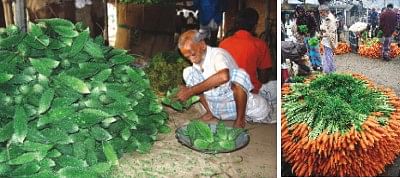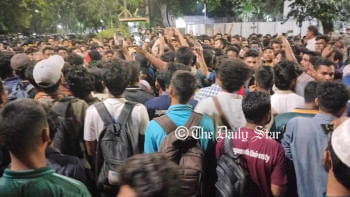Bogra switches to vegetable farming

Carrots are stacked at Mohasthangarh wholesale vegetables market. Photo:hasibur Rahman Bilu
Vegetables and spice cultivation in the 12 upazilas of Bogra district appears to be more profitable than growing paddy and other crops for farmers. It is not only less time consuming, but also promises greater yield at low costs.
Officials from the Department of Agricultural Extension (DAE) in Bogra said farmers in four upazilas, including Shibganj, started cultivating vegetables, spices and fruits about 20 years ago. They supply their agricultural produce to Dhaka and some northern districts.
DAE officials said 185,702 farmer families were involved in vegetables, spices and fruits cultivation commercially in 2002 in the district; now 596,188 farmers are producing 317,234 tonnes of vegetables by cultivating 17,836 hectares of land every year. In 1988, they cultivated 5410 hectares of land.
Md Ekram Hossain, deputy director of DAE Bogra, said farmers in Bogra are interested in cultivating vegetables, including potatoes, for higher yield and low production costs, coupled with high market demand.
“Farmers in Bogra have been cultivating a variety of vegetables and spices for commercial purposes for a long time. The cultivation of potatoes, tomatoes, pumpkins, cauliflowers, carrots and cabbages is profitable for the farmers,” said Hossain. Potato production has increased from 9.14 lakh tonnes to 11.33 lakh tonnes within a year in Bogra district, according to DAE officials.
Farmer Md Ayub Ali, 33, of Chornagachhi village in Shibganj upazila, said he made a profit of Tk 20,000 by cultivating vegetables and spices on 33 decimals of land last year. “I began growing vegetables commercially on 16 decimals of land about eight years ago,” he said.
“I usually earned Tk 16,000 from cultivating paddy on my piece of land by spending Tk 12,000. But growing vegetables is much more profitable in comparison,” he added.
Abdullah Al Mamun, sub-assistant agriculture officer of DAE Bogra, said the Bogra sadar, Shibganj, Shahjahanpur, Gabtoli, Sherpur, Dhunat and Sonatola upazilas are well known as the vegetables and spice producing areas.
“I started a vegetables business as a retailer at Rajabazar in Bogra town about eight years ago, at an investment of Tk 1,500. I used to earn Tk 150 a day as profit,” said Zaidul Pramanik.
He has 66 decimals of land in his village Ramasarpur, under Gabtoli upazila. He said he maintains his family with earnings from his business.
“Many women are working as labourers at Rajabazar and Fatialibazar in Bogra town and earning Tk 70 a day on average,” said Julekha Begum, 35. She has been working there as a cleaner for the last 12 years.
Wholesaler Mohammed Alam, 26, said he has been purchasing vegetables from Mohastangarh wholesale vegetables market for the last 18 years for onward supply to markets in Dhaka, Chittagong and Khulna.
“During the peak season, I buy 35 to 40 tonnes of vegetables and spices everyday to meet demand in the wholesale markets of Dhaka, Chittagong and Khulna. To my knowledge, at least 100 wholesalers invest their money in the business at the Mohastangarh vegetables market in October every year,” said Alam. He is currently sending 8 to 10 tonnes of vegetables to Dhaka and other markets in Bangladesh.
Another wholesaler Abdul Khaleque, 40, said he has been dealing in vegetables and spices for the last 15 years, to sell at wholesale markets in Dhaka and Chittagong.
Officials at DAE Bogra said the area of land brought under profitable vegetables cultivation is increasing every year. The weather here is conducive and production costs are also low, they added.
Farmers produced 1.51 lakh tonnes of potatoes by cultivating 12,065 hectares of land in the district in 1985; output has now grown ten times, covering 62,000 hectares of land.
However, farmers in Bogra have to sell their vegetables and potatoes along with other crops at low prices because there is a lack of storage facilities, officials said.
Farmers have to sell more than 8-9 lakh tonnes of potatoes for a lack of storage. There is not a single specialised cold storage in the northern region to preserve vegetables or fruits.

 For all latest news, follow The Daily Star's Google News channel.
For all latest news, follow The Daily Star's Google News channel. 



Comments